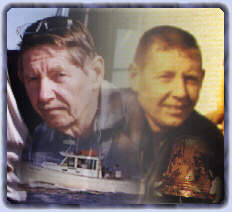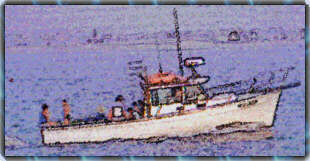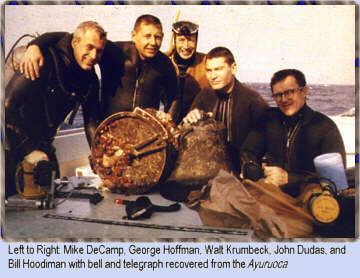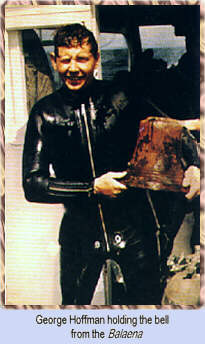Captain George Hoffman
Another entry from the Way-back machine:


"Gentleman George"
by Dan Berg
Note: George Hoffman passed away January 14, 1997, about a year after this article was written. His death is a great loss to the diving community and he will be missed by us all.
Captain George Hoffman runs his 36 foot Maine Coaster today much as he has for the past 30 years.
That's right, 1996 is George's 30th anniversary as a charter boat captain. Known as "Captain Nice" or "Gentleman George" to his passengers and crew, Capt. Hoffman has risen to the top of his field. He was one of the founding members and a past president of the Eastern Dive Boat Association, but there is much more to George than just running a dive boat. George is truly one of the original wreck divers on the east coast. He is a diver's diver who loves more than anything to get his feet wet and his hands dirty. Most content when digging up artifacts, George can occasionally be convinced to tell a story or two about his exploits. It's when he starts remembering dives and recounting adventures that the listener realizes George is the "Real McCoy."

Capt. Hoffman started diving in 1957. Back then he would dive off the only dive boat in New Jersey: the Comet, a 55 footer run by Max Bendix. When George started diving he would go with divers like Mike DeCamp, Ed Rush, Dick Hisinger and Norman Jager. He tells stories about leaving the dock on a Friday night and returning on Sunday, spending the weekend diving for lobsters and searching for shipwrecks. Capt. George started to operate his own boat, a Boston whaler, in 1966. He used the whaler for a season, then bought a 26ft Lures that was followed by a 38 ft wood boat, and finally his current vessel in 1981. All of the boats were called SEA LION, but George never bothered with numbers after the name.
In the early days, George purchased a pinging sonar and would spend days at sea searching for shipwrecks. He actually located quite a few; in fact, on a good day, George could locate three new shipwrecks. From these early exploits, George created his present-day LORAN list that is one of the most complete and accurate ever assembled. Many of the wrecks he discovered have never been explored, and every year Capt. Hoffman tries to get to at least one new set of numbers. Last year George took divers to a spot in the "Mud Hole" (a deep area near the entrance to New York Harbor), and when the divers surfaced they reported an intact "virgin" shipwreck.

George and his friends also identified a number of the wrecks enjoyed today by sport divers. They identified the Ayuruoca from a clock recovered by John Dudas, the Brunette from her artifacts, the Helen from a recovered builder's plaque, and the USS Bass from a wooden ammo box.
The Bass is one of George's favorite stories. The first time he dove the wreck was during a hurricane. They had attempted to get to the Andrea Doria but the seas were too rough. The fishing boat Captain said he had a wreck on the way in but thought it was too dangerous for divers. George replied, "If you can anchor to it we can dive it." George found the unidentified submarine bouncing across the ocean floor, being moved by the huge waves topside. Returning to the site a few weeks later, George and his buddies made a huge wrench to unscrew her hatch. After popping the hatch, they waited five minutes while a solid 48-inch column of air purged from the wreck. When the air stopped, they had to hold on to prevent being sucked into the sub. George recalls feeling as if he was in "a giant toilet bowl that had just been flushed." A few days later, he and Mike DeCamp were the first to enter the wreck. They found an ammo box with USS BASS stenciled on its side. These and other similar stories serve to confirm that George and his buddies, the ones who started New Jersey wreck diving, were the true explorers and adventurers of their day.

Other adventures at sea include stories of huge waves, treasure troves of artifacts, and monstrous lobsters. Over the years George has recovered all sorts of artifacts: he has the bell from the Balaena, a telegraph from the Choapa, and the helm from the Jacob Jones. In 1994 he recovered his most unusual artifact a tombstone from the Delaware. Captain George and his wife Mirna have turned their home into a shipwreck museum. Wall sconces made from deadeyes adorn the walls while they eat on china recovered from the Mohawk. Mirna even cooks with some of the steelware from the Stolt.
To me, it's George's devotion to the sport of wreck diving and his willingness to teach the new diver, it's the gentleman side that makes Capt. Hoffman so highly regarded amongst his peers. Many of the divers who serve as mates on George's boat go on to become captains themselves. These include Captain Dan Bressette, Captain Bob Archabald, Captain Livingston Walther, Captain Steve Sheering, and Captain Kevin Brennan. Even other dive boat captains (the "competition") hold George in the highest regard. In this industry, that is one of the highest compliments that could be given. My first experience with Capt. Hoffman was over ten years ago, and since then I have returned to dive off the SEA LION many times. To this day, every time George takes me diving I learn something new from the master.
In 1981 George suffered a heart attack. He was back in the water the very next season. In 1992 he had another coronary incident that resulted in bypass surgery. By the spring of 1993, George was back underwater exploring shipwrecks. Again in 1995, his diving was hampered by a mild stroke. Now fully recovered, he says he is looking forward to the 1996 season and cannot wait to jump overboard once again. When asked which is his favorite shipwreck, George replies: "It's the one I'm going to find next week."
About the Author:
Dan Berg is the author of ten shipwreck and diving-related books, and the host & producer of the award-winning Dive Wreck Valley television series.
Photos Courtesy Dan Berg and George Hoffman.
Original NJScuba website by Tracy Baker Wagner 1994-1996
